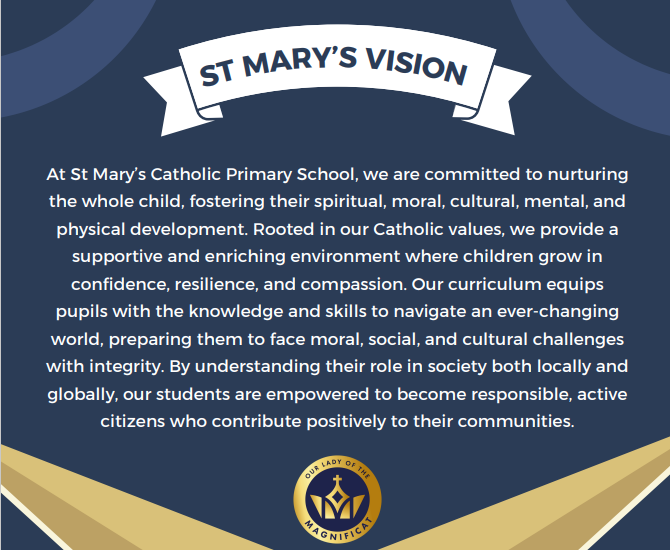
- Home
- Curriculum
- Subject Information
- Mathematics
Mathematics
Maths at st mary's catholic primary school
At St Mary’s Catholic Primary School, we aim to promote mathematical education, allowing children to develop their problem-solving skills, think critically, and approach challenges with confidence and resilience. We encourage students to reflect on their learning through the lens of Catholic values and virtues, which are central to our school and the Our Lady of the Magnificat Multi-Academy Trust. Students serve God by using their mathematical skills to understand and appreciate the order and patterns in the world around them, applying their knowledge to real-life situations and working collaboratively with others.
Intent:
The aims of mathematics teaching at St Mary's are based on the three aims of the National Curriculum for mathematics: fluency, reasoning and problem solving.
At St Mary’s, there are three elements to the mathematical curriculum.
Conceptual Understanding – to give children an integrated, relational and functional grasp of mathematics.
Fluency – To give pupils the knowledge and skills to use and apply procedures in a range of contexts.
Reasoning – To give pupils the language, methods, confidence and resilience to represent, reason about and solve problems which require knowledge of one or more concepts
Implementation:
In order to achieve the aims of this subject, there are several features that can be found within maths lessons, plans and schemes of work at St Mary's.
Blocked planning – Planning is based on White Rose Maths planning. Units are blocked around a concept to encourage a deep understanding.
Foundation facts – Within lessons, there are regular opportunities for revision/teaching of key number facts. These are matched to the age group to support all pupils in achieving their best.
Anchor tasks and stem sentences – Within a lesson, children take part in solving an ‘Anchor Task’, an anchoring problem that provides an opportunity for children to activate prior knowledge, collaborate to find an answer, debate and discuss a misconception and use mathematical language. Stem sentences are used throughout lessons to anchor an idea, promote recall and fluency and the use of mathematical language for all children.
Exploration tasks – Most lessons contain an ‘exploration task’ which is an opportunity for every student to engage with a reasoning or problem solving strand of maths.
Impact:
At St Mary's, teachers use a range of techniques to assess the impact of mathematics. These can include
Day-to-day formative assessment
Interim assessments
End of Key Stage assessments.
Please find below useful documents to discover more about maths at St Mary's.












